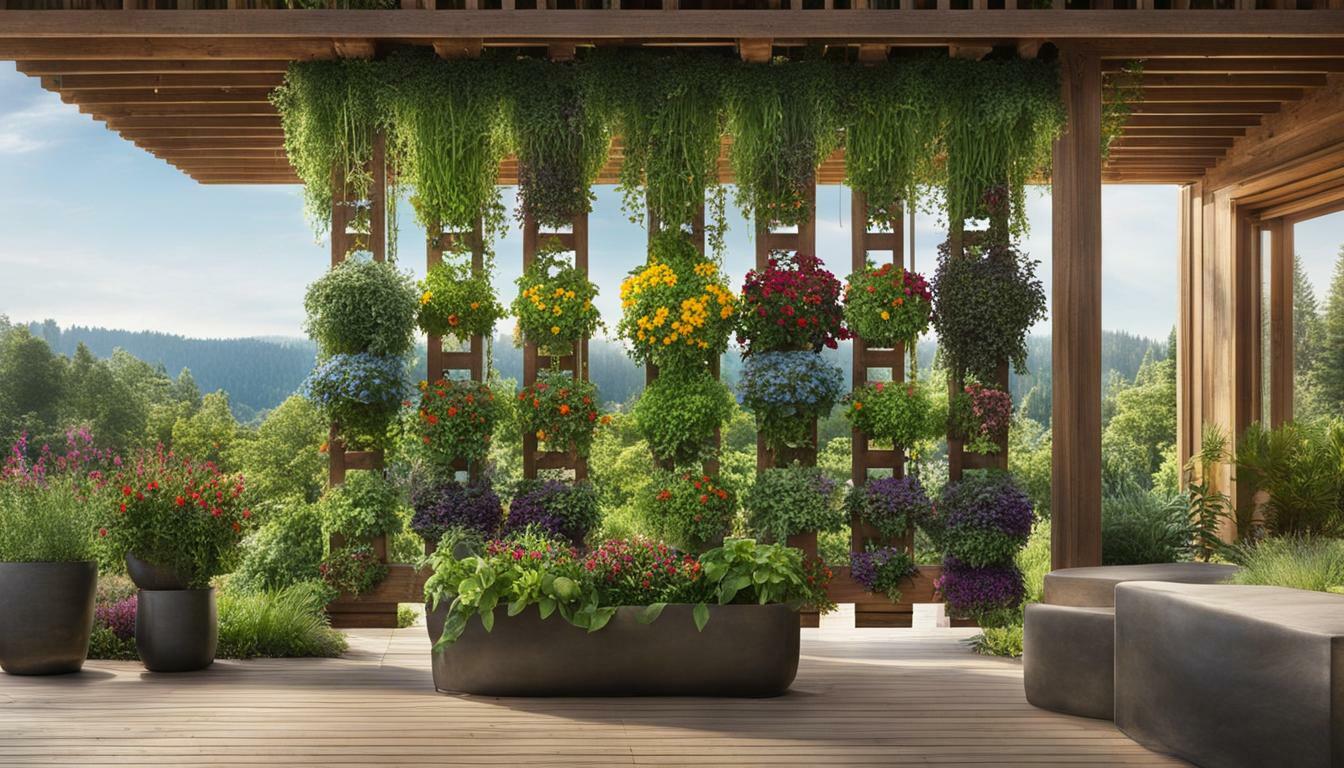Are you looking to maximize your gardening space and reduce waste? Learn how to create your own vertical garden with compost and enhance your living space while contributing to a greener environment.
Key Takeaways:
- Create a vertical garden using compost to maximize your gardening space.
- Vertical gardening with compost reduces waste and promotes a greener environment.
- Vertical gardens offer increased yields and easier maintenance.
- Choose the right plants for vertical gardening and train them to grow upward.
- Use trellises, arches, and other support structures for vertical gardening.
- Maintain your vertical garden by regularly watering and using compost for optimal plant health.
- Explore DIY ideas for creating your own vertical garden using compost.
- Follow tips and best practices for successful vertical gardening.
- Vertical gardening can be adapted to various settings, both indoors and outdoors.
- Vertical gardening with compost provides numerous benefits for sustainable green living.
Benefits of a Vertical Garden with Compost
Vertical gardening with compost offers numerous benefits that can help you grow healthier plants, increase your harvest, and make gardening easier on your back. By utilizing vertical space and incorporating compost into your gardening practices, you can maximize the potential of your garden![]() while promoting sustainability.
while promoting sustainability.
Here are some key benefits of vertical gardening with compost:
- Increased Yields: Vertical gardening allows you to grow more plants in a smaller area, making maximum use of limited space. By utilizing trellises, arches, and other vertical structures, you can grow a greater variety of plants and increase your overall harvest.
- Reduced Disease Risks: By elevating your plants off the ground, vertical gardening helps to improve air circulation and reduce the risk of diseases caused by moisture-loving fungi. This can lead to healthier plants and fewer pest problems.
- Improved Air Circulation: Vertical gardening allows for better air circulation around your plants, which can help prevent the buildup of excess moisture and reduce the risk of fungal diseases. It also helps to promote photosynthesis by exposing more leaf surfaces to sunlight.
- Back-Saving Convenience: One of the major advantages of vertical gardening is that it eliminates the need for bending and kneeling, making it easier on your back. Harvesting from a vertical garden is a breeze as the plants are at a higher level, reducing strain on your body.
With these benefits in mind, it’s clear that vertical gardening with compost is a fantastic way to optimize your gardening space and enjoy the rewards of a thriving garden.
Vertical Gardening with Compost: Tips for Success
When it comes to vertical gardening with compost, there are a few tips to keep in mind for successful results:
- Choose the Right Plants: Select vining and sprawling plants that can be trained to grow upward, using less horizontal space. Look for varieties that thrive in your climate and consider their growth habits and support needs.
- Use a Good Soil and Compost Mix: Ensure your vertical garden has a well-draining soil mix enriched with compost. This will provide the necessary nutrients for your plants to thrive and promote healthy root development.
- Proper Support Structures: Invest in sturdy support structures such as trellises, arches, or pergolas that can accommodate the weight of your plants. Make sure they are securely anchored to prevent toppling.
- Maintain and Water Regularly: Regularly check your vertical garden for signs of watering needs. Vertical gardens may require more frequent watering, especially wall-mounted planters. Consider using micro or drip irrigation systems to efficiently deliver water to your plants.
- Monitor for Pests and Diseases: Keep an eye out for pests and diseases and address them promptly. Regularly inspect your plants for any signs of damage or infestation and take appropriate measures to prevent their spread.
By following these tips and harnessing the benefits of vertical gardening with compost, you can create a thriving garden that maximizes space, promotes plant health, and simplifies the gardening process.
| Plant | Varieties |
|---|---|
| Pole Beans | ‘Blue Lake’, ‘Kentucky Wonder’, ‘Scarlet Runner’ |
| Cucumbers | ‘Lemon’, ‘Armenian’, ‘Straight Eight’ |
| Vining Tomatoes | ‘Sweet 100’, ‘Cherry Cascade’, ‘Yellow Pear’ |
| Zucchini | ‘Black Beauty’, ‘Golden Zucchini’, ‘Costata Romanesco’ |
By selecting the right plants, providing proper support, and maintaining your vertical garden with compost, you can create a stunning and productive garden that maximizes space and yields a bountiful harvest.
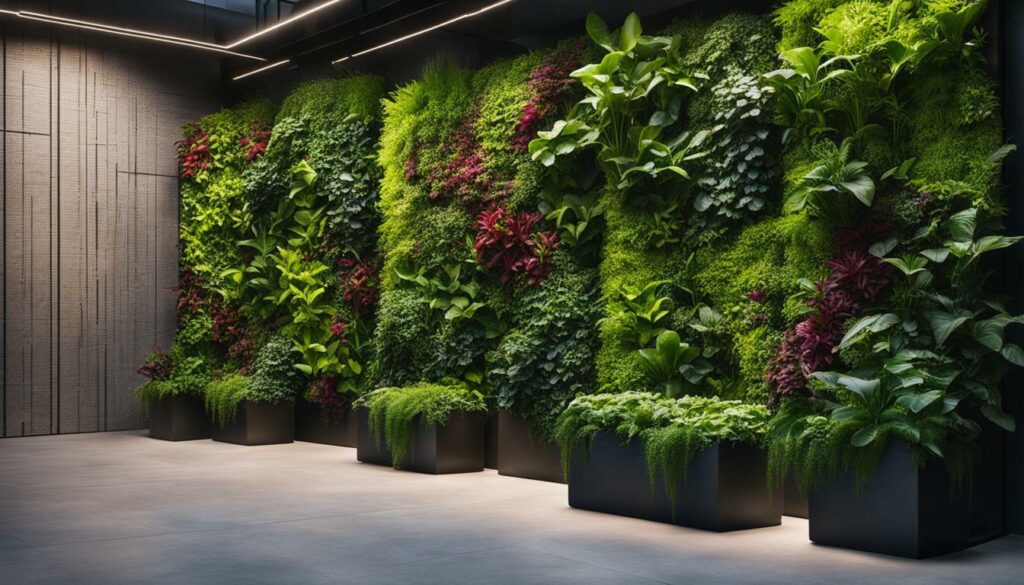
Choosing the Right Plants for Vertical Gardening
When it comes to vertical gardening, choosing the right plants is crucial. Opt for vining and sprawling varieties that can be easily trained to grow upward, making the most of your vertical garden space. These plants not only maximize your growing area but also add visual interest to your garden.
Vining plants, such as pole beans and vining tomatoes, are ideal for vertical gardening. They have long tendrils or stems that can be trained to climb trellises, arches, or other support structures. These plants take up less horizontal space on the ground but provide abundant yields when grown vertically. Consider varieties like ‘Sungold’ and ‘Black Cherry’ for cherry tomatoes, and ‘Romano Italian’ and ‘Meraviglia Venezia’ for green beans.
Another excellent option for vertical gardening is sprawling plants that can be trained to climb. Varieties like zucchini, cucumber, and melon can be guided up supports, saving horizontal space and allowing the plants to grow upward. Choose acorn squash, delicata squash, yellow summer squash, and zucchini for a delicious harvest from your vertical garden.
To help you choose the right plants, refer to the table below for some recommended varieties:
| Plant | Varieties |
|---|---|
| Cherry Tomato | ‘Sungold’, ‘Black Cherry’, ‘Gardener’s Delight’, ‘Blondkopfchen’ |
| Cucumber | ‘Burpee Hybrid II’, ‘County Fair 83’, ‘Dasher 11’, ‘Saladin’ |
| Green Bean | ‘Romano Italian’, ‘Meraviglia Venezia’, ‘Gold of Bacau’ |
| Melon | ‘Delicious 51’, ‘Tigger’, ‘Sleeping Beauty’ (musk melon); ‘White Wonder’, ‘Yellow Doll’ (watermelon) |
| Pea | ‘Dual’, ‘Garden Sweet’, ‘Maestro’, ‘Sugar Snap’, ‘Super Sugar Snap’ |
| Squash | acorn, delicata, yellow summer, zucchini |
By selecting the right plants for vertical gardening, you can make the most of your vertical space and enjoy bountiful harvests.
Building Support Structures for Vertical Gardening
A solid support structure is essential for a successful vertical garden. Explore various options like trellises, arches, and pergolas, and learn how to create the perfect soil and compost mix for your vertical garden.
When it comes to building support structures for vertical gardening, there are several options to consider. Trellises, arches, and pergolas are all popular choices that provide sturdy support for climbing plants. These structures not only add beauty and visual interest to your garden but also maximize space by allowing plants to grow upward.
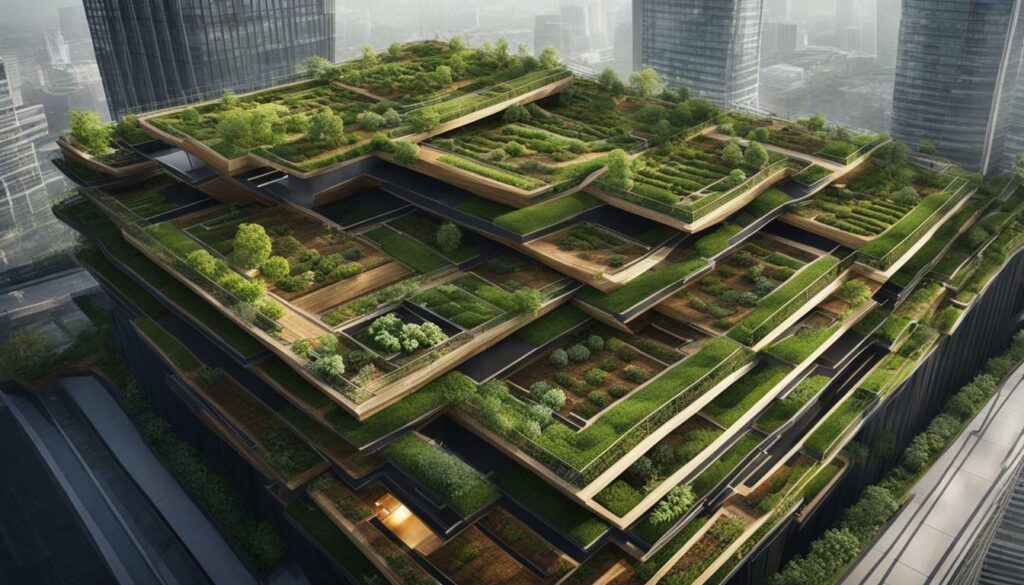
When selecting a support structure, it’s important to consider the needs of your plants. Some vining plants, like pole beans and sweet peas, do well on trellises. These structures can be purchased or easily made from woody pruning. For more substantial plants, such as grapevines, an arch or pergola may be a better choice. These structures provide the necessary support for the weight of mature plants and can create a stunning focal point in your garden.
Once you have chosen your support structure, it’s time to focus on the soil and compost mix for your vertical garden. It’s important to create a well-draining mixture that retains enough moisture for your plants to thrive. Consider using a blend of organic compost, peat moss, and vermiculite or perlite to create a lightweight and nutrient-rich soil mix. This will help provide the necessary nutrients for your plants to flourish.
| Support Structure | Best Plants |
|---|---|
| Trellises | Pole beans, sweet peas, cucumbers |
| Arches | Grapevines, vining tomatoes |
| Pergolas | Fruit trees, climbing roses |
Remember to securely anchor your support structure in the ground to prevent it from toppling over. Regularly check the stability of your structure and make any necessary repairs or adjustments.
By choosing the right support structure and creating a suitable soil and compost mix, you can ensure that your vertical garden will thrive and provide a beautiful and productive space for your plants to grow.
Key Points:
- A solid support structure is essential for a successful vertical garden.
- Trellises, arches, and pergolas are popular options for vertical gardening.
- Choose a support structure based on the needs of your plants.
- Create a well-draining soil and compost mix using organic compost, peat moss, and vermiculite or perlite.
- Securely anchor your support structure in the ground to prevent toppling.
Maintaining and Watering Your Vertical Garden
Proper maintenance and watering are key to the success of your vertical garden. Learn the essentials of composting, utilizing compost in vertical gardening, and effective watering tips for a thriving vertical garden.
“Vertical gardens might need more frequent watering.”
One of the challenges of vertical gardening is ensuring that your plants receive adequate hydration, especially in wall-mounted planters that may be more prone to drying out due to the rain shadow effect. To address this, micro or drip irrigation systems can be a valuable tool for efficient water delivery. These systems can be coupled with timers to automate watering and ensure consistent moisture levels for your plants.
“Composting plays a vital role in vertical gardening.”
Composting is an essential practice for maintaining healthy soil and promoting nutrient-rich growth in vertical gardens. By adding compost to your soil or using a compost-based potting mix, you can improve soil structure, enhance drainage, and provide essential nutrients for your plants. Composting also helps to retain moisture in the soil, reducing the frequency of watering and promoting water conservation.
“Effective watering techniques can make all the difference.”
When watering your vertical garden, it’s important to ensure that the water reaches the roots of your plants. Watering from the top may not penetrate the layers of soil and reach the lower levels of your vertical garden. To address this, consider using a watering can with a long spout or a drip irrigation system that delivers water directly to the plant’s root zone.
Vertical Garden Watering Tips:
- Water your vertical garden in the early morning or late evening to reduce evaporation and allow plants to absorb water before the heat of the day.
- Monitor soil moisture levels regularly and adjust watering frequency based on your plant’s needs and environmental conditions.
- Avoid overwatering by ensuring that the soil is moist but not waterlogged. Soggy soil can lead to root rot and other plant diseases.
- Consider using a moisture meter to accurately gauge the moisture content of your soil and determine when to water.
- Regularly check for signs of underwatering or overwatering, such as wilting or yellowing leaves, and adjust your watering routine accordingly.

| Vertical Garden Composting Tips | How to Use Compost in Vertical Gardening |
|---|---|
| 1. Start composting by collecting kitchen scraps, yard waste, and other organic materials. Avoid adding meat, dairy, and oily items to your compost pile. | 1. Mix compost into your potting soil or garden bed to enrich the soil with organic matter. |
| 2. Turn your compost regularly to promote decomposition and prevent odors. Keep the compost moist but not soggy. | 2. Top-dress your vertical garden with compost to provide a slow-release source of nutrients for your plants. |
| 3. Use a compost activator or accelerator to speed up the composting process. | 3. Incorporate compost into the planting holes when transplanting or installing new plants in your vertical garden. |
| 4. Harvest mature compost when it has turned dark and crumbly, resembling rich, fertile soil. | 4. Apply a layer of compost as mulch around the base of your plants to conserve moisture and suppress weeds. |
By incorporating compost and implementing effective watering techniques, you can ensure the health and vitality of your vertical garden. Remember to monitor your plants’ moisture needs and adjust your watering routine accordingly. With proper maintenance and care, your vertical garden will thrive and provide a beautiful and sustainable addition to your living space.
DIY Vertical Gardening Ideas
Get creative and unleash your DIY skills with these exciting ideas for building your own vertical garden using compost. Whether you have a small balcony or a spacious backyard, these projects will help you maximize your growing space and create a stunning green oasis.
1. Living Wall
Create a living wall by securing a trellis panel onto a wall or fence. Use pots or fabric pocket planters to hold a variety of herbs, vegetables, and flowers. Line the pots with black plastic for drainage, fill them with compost, and plant your desired crops. Hang the pots on the trellis panel, spacing them evenly for a visually appealing display. Regularly water and care for your plants to keep the living wall lush and vibrant.
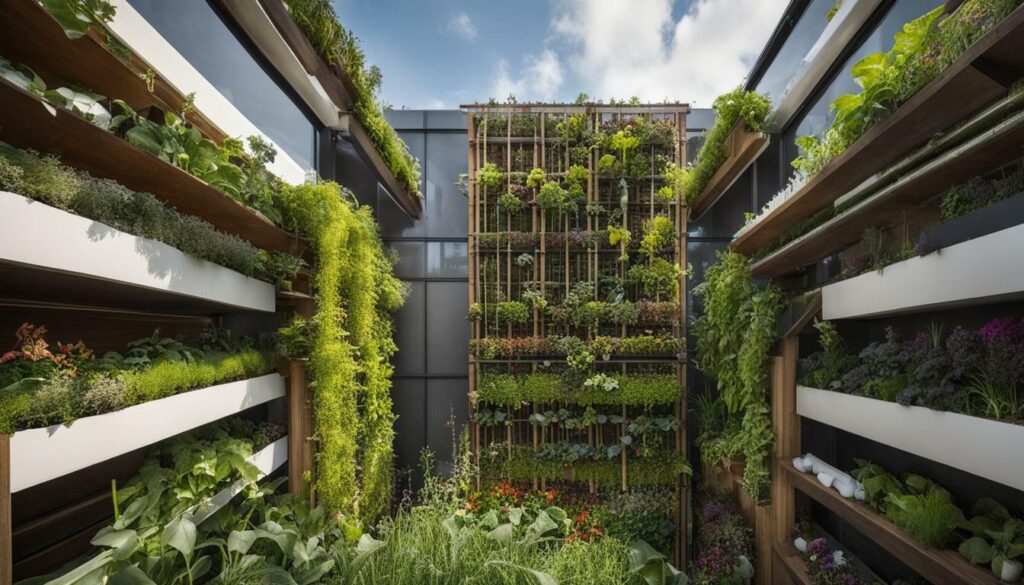
2. Vegetable Arch
Build a walk-through vegetable arch using galvanized metal uprights and cattle panels. Create planting trenches on either side of the arch and backfill them with nutrient-rich organic matter and soil. Cut the cattle panels to size, securing them to the posts with zip ties. Plant climbing vegetables like beans, cucumbers, and squash in the trenches. As the plants grow, they will create a stunning archway and make harvesting a breeze.
3. Trellis Planters
Add trellis planters against a wall or fence to support climbing plants like tomatoes, peas, and beans. Choose trellises with built-in boxes for extra growing space. You can also attach hanging baskets to the trellis panel for added decorative appeal. Ensure the trellis is sturdy enough to support the weight of mature plants and secure it properly to prevent toppling over.
4. Hanging Wall Planters
Mount wall-mounted planters on any flat surface to create a beautiful vertical garden. Choose from a variety of hanging pots, wicker baskets, or circular planters to suit your style. Wall planters are easy to care for and allow you to easily swap out plants or rearrange your garden display. They add a touch of glamour and style to any space, whether indoors or outdoors.
5. Stackable Fruit and Herb Planters
Maximize your growing space with stackable planters that can hold multiple plants in a compact design. These planters are perfect for small spaces and can be placed indoors or outdoors. Each planter consists of stackable pots with soil separators and drainage holes. Fill them with compost and plant a variety of herbs, salad greens, legumes, and more. Stackable planters are not only functional but also visually appealing, adding a unique touch to your vertical garden.
| Recommended Plants for Vertical Gardening | |
|---|---|
| Pole Beans | Sungold, Black Cherry, Gardener’s Delight, Blondkopfchen |
| Cucumbers | Burpee Hybrid II, County Fair 83, Dasher 11, Saladin |
| Green Beans | Romano Italian, Meraviglia Venezia, Gold of Bacau |
| Lima Beans | Doctor Martin, King of the Garden |
| Melon | Delicious 51, Tigger, Sleeping Beauty (musk melon); White Wonder, Yellow Doll (watermelon) |
| Pea | Dual, Garden Sweet, Maestro, Sugar Snap, Super Sugar Snap |
| Squash | Acorn, Delicata, Yellow Summer, Zucchini |
Get started on your DIY vertical garden project today and enjoy the benefits of growing your own fresh produce while adding beauty and greenery to your space.
Tips for Successful Vertical Gardening
Take your vertical gardening skills to the next level with these expert tips and tricks that will help you choose the right plants, optimize composting in your vertical garden, and effectively maintain your green oasis.
1. Choose the Right Plants
When it comes to vertical gardening, selecting the right plants is crucial. Opt for vining, rambling, and sprawling varieties that can be trained to grow upward, using less horizontal space. Some excellent choices include pole beans, climbing peas, vining tomatoes, and sprawling types of zucchini, cucumber, melon, and squash. Consider cherry tomatoes like ‘Sungold’ or ‘Black Cherry’, cucumbers like ‘Burpee Hybrid II’ or ‘County Fair 83’, and green beans like ‘Romano Italian’ or ‘Meraviglia Venezia’. These plants are not only suitable for vertical growth but also offer delicious rewards at harvest time.
2. Optimize Composting
Composting is a vital practice for vertical gardening success. Incorporate compost into your soil and compost mix to provide essential nutrients and improve soil fertility. Compost acts as a natural fertilizer, enriching the soil and promoting healthy plant growth. It also helps retain moisture, reducing the need for frequent watering. Consider using a composting system specifically designed for vertical gardens to efficiently recycle organic waste and create nutrient-rich compost for your plants.
3. Effective Maintenance
Maintaining your vertical garden is essential for its long-term success. Regularly inspect your plants for signs of pests or disease and take appropriate action immediately. Prune and train your plants to ensure they grow in the desired direction and maintain proper airflow. Water your vertical garden thoroughly and practice proper watering techniques, such as using drip irrigation systems or watering at the base of plants to avoid wetting the foliage excessively. Remember, while vertical gardens may require more frequent watering, proper composting can help retain moisture and reduce water consumption.
4. Additional Tips and Tricks
Here are some additional tips to ensure successful vertical gardening:
- Provide adequate support structures, such as trellises or arches, to accommodate the weight and growth of your plants.
- Position your vertical garden in a location that receives sufficient sunlight, typically 6 to 8 hours of direct sunlight.
- Regularly monitor and adjust the positioning of your plants to ensure optimal sun exposure.
- Consider using companion planting techniques to maximize the use of space and deter pests.
- Regularly fertilize your plants with organic compost or liquid fertilizers to promote healthy growth.
By following these tips and tricks, you’ll be well on your way to creating a thriving vertical garden that not only maximizes space but also provides a bountiful harvest.
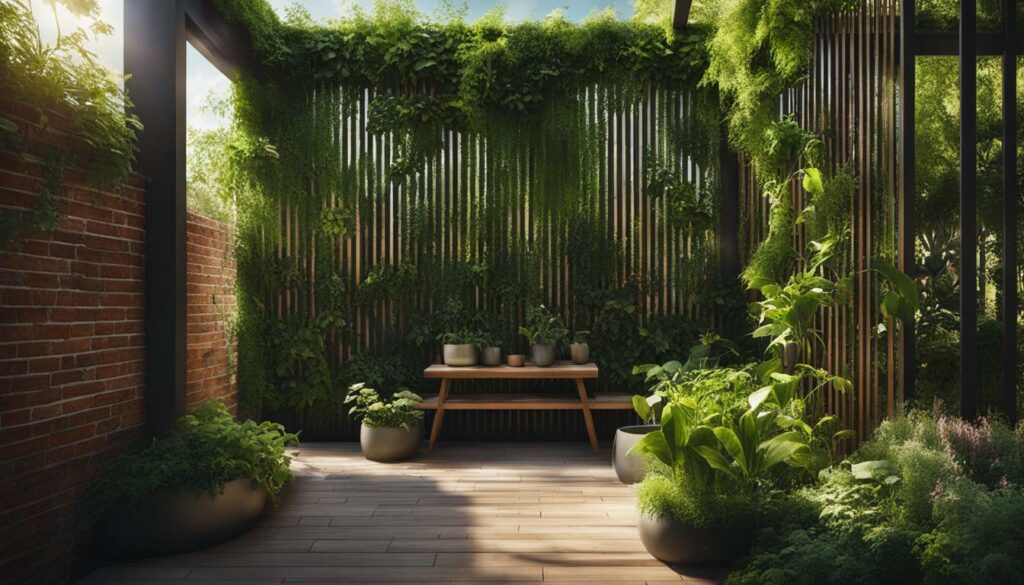
| Plant | Best Varieties |
|---|---|
| Cherry Tomato | ‘Sungold’, ‘Black Cherry’, ‘Gardener’s Delight’, ‘Blondkopfchen’ |
| Cucumber | ‘Burpee Hybrid II’, ‘County Fair 83’, ‘Dasher 11’, ‘Saladin’ |
| Green Bean | ‘Romano Italian’, ‘Meraviglia Venezia’, ‘Gold of Bacau’ |
| Melon | ‘Delicious 51’, ‘Tigger’, ‘Sleeping Beauty’ (musk melon); ‘White Wonder’, ‘Yellow Doll’ (watermelon) |
| Pea | ‘Dual’, ‘Garden Sweet’, ‘Maestro’, ‘Sugar Snap’, ‘Super Sugar Snap’ |
| Squash | acorn, delicata, yellow summer, zucchini |
Vertical Gardening in Different Settings
Whether you have a small balcony or a spacious backyard, vertical gardening can be tailored to suit any setting, making it a versatile and accessible gardening option for everyone. Vertical gardens can be created indoors or outdoors, allowing you to maximize your growing space and create a lush green oasis in any environment.
When it comes to indoor settings, vertical gardens can be mounted on walls, pillars, or railings, adding a touch of nature to your living space. These gardens can help improve air quality ![]() and create a calming atmosphere, especially in urban areas with limited access to green spaces. Wall gardens, with plants cascading down the wall in a beautiful display, can transform a bland space into a vibrant and inviting one.
and create a calming atmosphere, especially in urban areas with limited access to green spaces. Wall gardens, with plants cascading down the wall in a beautiful display, can transform a bland space into a vibrant and inviting one.
In outdoor settings, vertical gardens can be created using trellises, arches, pergolas, and towers. These structures not only provide support for climbing plants but also add visual interest and define different areas of your garden. Trellises and arches, in particular, are excellent options for growing vining plants such as beans, peas, and cucumbers. Tower gardens, on the other hand, offer a vertical growing medium that is perfect for salad greens, herbs, and compact vegetables.
| Vertical Garden Element | Best for |
|---|---|
| Trellises and arches | Supporting vining plants like beans, peas, and cucumbers |
| Tower gardens | Growing salad greens, herbs, and compact vegetables |
| Wall gardens | Creating a living wall or adding visual interest to indoor and outdoor spaces |
Vertical gardening allows you to make the most of your available space and create a stunning garden even in tight quarters. Whether you live in an apartment, have a small backyard, or want to add greenery to your office, vertical gardening provides a flexible and customizable solution. So, no matter where you are, vertical gardening with compost can help you bring nature indoors or transform your outdoor space into a thriving oasis.
Conclusion
In conclusion, vertical gardening with compost offers a range of benefits, from maximizing space and increasing yields to reducing waste and promoting sustainable gardening practices. By growing your own vertical garden with compost, you can enjoy fresh produce right at your fingertips, while also contributing to a greener future.
One of the main advantages of vertical gardening with compost is the efficient use of space. By utilizing trellises, arches, and other support structures, you can grow a variety of plants in a small area, maximizing your growing potential. This is especially beneficial for those with limited outdoor space or urban gardens.
Furthermore, vertical gardening with compost can lead to increased yields. The use of compost as a nutrient-rich soil amendment promotes healthy plant growth, resulting in larger, more abundant harvests. Compost provides essential nutrients to the plants, ensuring they have everything they need to thrive.
In addition to increased yields, vertical gardening with compost offers other advantages. By training plants to grow upward, you can reduce the risk of disease and pests, as the foliage and fruit are elevated off the ground. Improved air circulation also helps prevent moisture-related issues, such as powdery mildew and rusts. Plus, vertical gardening makes it easier to care for your plants and harvest, as you can avoid bending and kneeling.
To start your own vertical garden with compost, choose the right plants that are suitable for vertical growth, such as vining and sprawling varieties. These plants can be trained to grow upward, taking advantage of the vertical space and using less horizontal area. Make sure to use a suitable soil and compost mix that provides the necessary nutrients and drainage.
Maintaining and watering your vertical garden is important for its success. Regular composting helps replenish nutrients in the soil, ensuring the health of your plants. Effective watering techniques, such as drip irrigation systems, can help conserve water and deliver it efficiently to your vertical garden.
If you enjoy DIY projects, there are plenty of ideas for creating your own vertical garden with compost. From living walls to vegetable arches, the possibilities are endless. Get creative and customize your vertical garden to suit your space and preferences.
Lastly, remember to follow tips for successful vertical gardening, such as proper plant selection, composting tips, and best practices for maintenance. By implementing these tips, you can ensure the health and productivity of your vertical garden.
Vertical gardening with compost can be adapted to various settings, whether indoors or outdoors. It offers a versatile gardening solution for those looking to grow their own produce, regardless of space limitations or location.
Start your own vertical garden with compost today and enjoy the many benefits it brings. Not only will you have a thriving garden, but you will also contribute to a more sustainable and eco-friendly future.
Can I Use Compost for Low Maintenance Indoor Vertical Gardens as Well?
Yes, you can use compost for low maintenance indoor gardens. Compost provides essential nutrients for plants to thrive in a vertical garden. It also helps retain moisture, reducing the need for frequent watering. This makes it a great option for creating thriving and low maintenance indoor gardens.
FAQ
Q: What are the benefits of vertical gardening with compost?
A: Vertical gardening with compost offers increased yields, reduced disease risks, improved air circulation, and convenience. Compost provides nutrients to the plants and helps retain moisture in the vertical garden.
Q: How do I choose the right plants for vertical gardening?
A: Select vining and sprawling varieties that can be trained to grow upward, using less horizontal space. Some suitable plants for vertical gardening include pole beans, climbing peas, vining tomatoes, and sprawling types of zucchini, cucumber, melon, and squash.
Q: What support structures are best for vertical gardening?
A: Trellises, arches, and pergolas are ideal for vertical gardening. Ensure the support structure is able to accommodate the weight of the plants and is securely anchored. Use a suitable soil and compost mix for optimal plant growth.
Q: How do I maintain and water my vertical garden?
A: Regularly maintain and harvest from your vertical garden. Watering frequency may be higher for vertical gardens, especially for wall-mounted planters. Consider using micro or drip irrigation systems coupled with a timer for efficient watering.
Q: What are some DIY ideas for vertical gardening?
A: Create a living wall, a vegetable arch, or other creative projects using compost. These DIY ideas provide attractive and functional ways to grow plants vertically in limited space.
Q: What tips can you share for successful vertical gardening?
A: Choose the right plants, use proper composting techniques, and maintain your vertical garden regularly. Proper plant selection and vertical garden composting tips can ensure successful vertical gardening.
Q: Can vertical gardening be done in different settings?
A: Yes, vertical gardening can be adapted to various settings, such as indoor and outdoor spaces. It offers flexibility and versatility in creating a vertical garden in any environment.
Q: What are the overall benefits of vertical gardening with compost?
A: Vertical gardening with compost allows for maximum use of space, increased yields, reduced disease risks, improved air circulation, and convenience. It is a sustainable gardening practice that promotes healthy plant growth and maximizes gardening potential.

